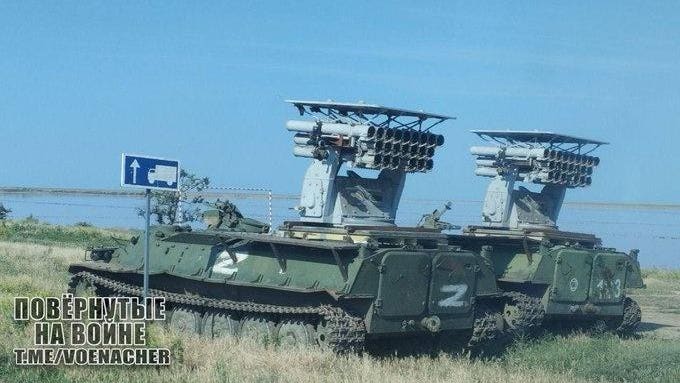The Antonivskyi bridge is the main span across the wide Dnipro River south of Kherson in southern Ukraine. After liberating Kherson from Russian occupation last fall, Ukrainian troops in late June forced their way across the bridge—and secured their first major lodgement on the Dnipro’s left bank.
The lodgement is a serious threat to Russia’s hold on southern Kherson Oblast and, by extension, its nine-year occupation of the Crimean Peninsula, farther to the south. All things being equal, the Russian army would organize forces for a major counterattack aimed at dislodging the lodgement.
All things aren’t equal. Ukrainian brigades are attacking along several axes in Zaporizhzhia and Donetsk Oblasts, east of Kherson, as well as around the ruins of Bakhmut in eastern Ukraine’s Donbas region.
After losing thousands of troops and hundreds of vehicles capturing Bakhmut in a yearlong operation that culminated in May, Russian troops are stretched thin all across the 600-mile-long Ukraine front. It should come as no surprise, then, that the Russians are attacking the Antonivskyi bridge lodgement with some of their weirdest improvised weapons.
None are weirder than the old MT-LB tractors that Russian technicians recently fitted with A-22 rocket-launchers they borrowed from warships. The MT-LB-A-22s with their 22 tubes for 140-millimeter rockets first appeared in a photo that circulated online in early June.
The MT-LB rocket-launchers are part of a broader trend. Having lost more than 10,000 modern vehicles in the first 17 months of its wider war on Ukraine, Russia is growing desperate for heavy weaponry.
Production of new tanks, fighting vehicles and artillery—hamstrung by foreign sanctions—alone can’t make good Russia’s losses, so technicians are scrounging old chassis, turrets, guns and launchers and mixing and matching them to produce the vehicular equivalents of Frankenstein’s monster.
These include 1970s-vintage MT-LB armored tractors packing a bewildering array of guns and launchers, including several gun and launcher types that originally armed naval vessels. In March, MT-LBs fitted with 2M-3 and 2M-7 gun mounts first appeared. These vehicles apparently are crude air-defenses.
The MT-LB-A-22 by contrast is a fire-support vehicle. The A-22 launcher, which also arms Russian navy amphibious vessels, can fire unguided rockets out to a distance of five miles or so.
That’s not very far for a rocket-launcher. One of Ukraine’s American-made High-Mobility Artillery Rocket Systems can fire 227-millimeter rockets as far as 40 miles. The A-22’s 17-pound rockets also lack punch and accuracy compared to a HIMARS’s 680-pound, GPS-guided rockets.
On a warship, the A-22 benefits from colocated optical aiming hardware. But the DVU-3-BS rangefinder is too bulky to fit on a 13-ton MT-LB. It seems the Russians have fitted crude sights to the A-22 launchers on the improvised rocket vehicles. Don’t count on these sights working very well. An MT-LB-A-22 crew’s approach to fire-control is to point, spray and pray.
But that doesn’t mean the Russians aren’t trying. After struggling for weeks to dislodge the Ukrainian troops on the southern side of the Antonivskyi bridge—even apparently firing at least one Iskander ballistic missile—Russian troops on the left bank of Dnipro rolled an MT-LB-A-22 into action.
A dramatic video that appeared online this weekend depicts one of the Frankenlaunchers lobbing a full salvo reportedly in the direction of the Antonivskyi bridge.
Whether the 22 rockets hit anything of value is hard to say. In any event, don’t expect the Ukrainians to give up their lodgement at the bridge without a serious fight. It undoubtedly will take more than a DIY rocket-launcher.
Read the full article here





